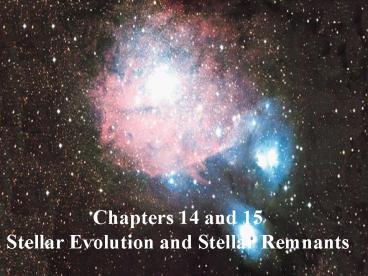Chapters 14 and 15 Stellar Evolution and Stellar Remnants PowerPoint PPT Presentation
Title: Chapters 14 and 15 Stellar Evolution and Stellar Remnants
1
Chapters 14 and 15 Stellar Evolution and
Stellar Remnants
2
Star Birth Nebula
3
Young star Protostar
4
Adult Main Sequence
- As the temperature in the interior rises,
nuclear reactions produce outward force and
balances the inward force of gravity ?
hydrostatic equilibrium star becomes stable and
contraction stops?main-sequence star
5
Energy Sources in Stars
- 4 hydrogen nuclei fuse to become 1 helium nucleus
- Since the mass of 4 hydrogen nuclei is greater
than the mass of 1 helium nucleus, the leftover
mass (0.7) is converted to energy by Einsteins
equation Emc2
6
The end states of stars depends upon its mass!
The more massive a star, the faster it consumes
its fuel, the shorter its lifetime
7
A B C
8
Evolution of Low Mass Stars including our Sun M
lt 10 Solar Masses
9
Old Age Red Giant
10
(No Transcript)
11
Elderly, core White Dwarf
The core of the white dwarf star is now all
carbon and oxygen
12
Elderly, envelope Planetary nebula
Ring Nebula
Eskimo Nebula
13
Yeah, but what about the really Massive stars?
14
Old Age Red Supergiant
15
(No Transcript)
16
Figure 13.19
Elderly, dying starSupernova
17
Super Nova Remnants
18
Our Sun will never explode. Only massive stars
explode as supernova!
19
Elderly, core Neutron Star
Core
High mass stars becomes so dense that
protons and electrons combine to become neutrons
and star becomes neutron star
20
Life Cycle of a Low Mass Star
21
Life Cycle of a High Mass Star
PowerShow.com is a leading presentation sharing website. It has millions of presentations already uploaded and available with 1,000s more being uploaded by its users every day. Whatever your area of interest, here you’ll be able to find and view presentations you’ll love and possibly download. And, best of all, it is completely free and easy to use.
You might even have a presentation you’d like to share with others. If so, just upload it to PowerShow.com. We’ll convert it to an HTML5 slideshow that includes all the media types you’ve already added: audio, video, music, pictures, animations and transition effects. Then you can share it with your target audience as well as PowerShow.com’s millions of monthly visitors. And, again, it’s all free.
About the Developers
PowerShow.com is brought to you by CrystalGraphics, the award-winning developer and market-leading publisher of rich-media enhancement products for presentations. Our product offerings include millions of PowerPoint templates, diagrams, animated 3D characters and more.

